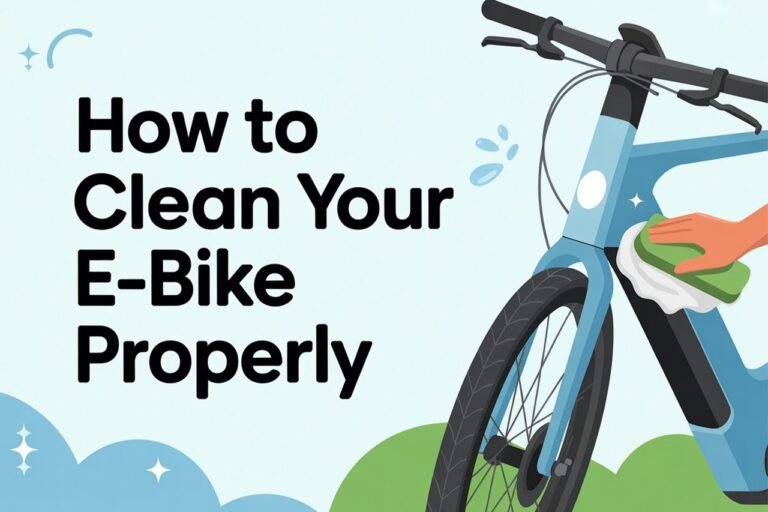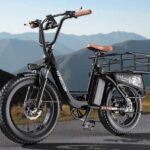
Have you ever wondered if you can really lose weight riding an electric bike? Maybe you’ve seen e-bikes cruising by and thought, “That looks fun, but can it actually help me get fit?”
E-bikes offer a highly effective way to lose weight and improve fitness by combining the benefits of cycling with the accessibility and ease of electric assistance. Consistent use of an e-bike can burn calories, improve cardiovascular health, and make regular exercise enjoyable and sustainable for a wider range of people.
In this article, we’ll dig into the science and practical details behind using your e-bike for weight loss. We’ll cover how it works, why it’s effective, and break down 10 proven strategies—complete with practical tips and motivation to help you hit your weight loss goals.
How E-Biking Supports Weight Loss
E-bikes are often misunderstood as “cheating” compared to regular bikes, but research shows they can be a powerful weight loss tool. Electric assistance doesn’t mean zero effort—it means you can ride longer, more often, and tackle tougher routes . The motor lets you keep moving when you’d otherwise stop, which is crucial for consistent calorie burn.
A major benefit: e-bikes remove barriers. If you’re returning to exercise, dealing with injuries, or have a lot of weight to lose, e-bikes make cycling accessible. You’re still pedaling, engaging muscles, and raising your heart rate, but the assistance smooths out hills and keeps you from burning out too soon.
How Many Calories Can You Burn?
- Casual e-bike ride (PAS Mode 2): 300–500 calories/hour
- Moderate intensity (PAS Mode 3+): 400–700 calories/hour
- Vigorous effort, minimal assist: 600–900 calories/hour
Numbers based on rider weight (70–90 kg) and typical e-bike settings. For reference, traditional cycling burns 400–900 calories/hour depending on intensity .
Here’s a quick comparison table:
| Activity | Calories Burned (1 hr) |
|---|---|
| Walking | 200–350 |
| E-Bike (Moderate) | 400–700 |
| Regular Bike | 400–900 |
| Running | 600–1000 |
So yes, you can absolutely lose weight riding an e-bike—the key is using it consistently and strategically.
1. Set Clear, Achievable Goals
Don’t just say, “I want to lose weight.” Get specific! SMART goals (Specific, Measurable, Achievable, Relevant, Time-bound) work best.
- Example: “I will ride my e-bike 5 days a week for 45 minutes, aiming to lose 1 kg (2 lbs) per month.”
Track your starting weight, take a few photos, and measure your waist. Progress is more than just the number on the scale. Celebrate every milestone, no matter how small.
Pro tip: Use a fitness app like Strava or Komoot to log your rides and watch your progress add up.
2. Plan Your Rides for Maximum Burn
Structure matters. Riding randomly whenever you feel like it won’t deliver the same results as a steady schedule. Consistency is everything!
- Commit to a weekly plan: 3–5 sessions, 45–60 minutes each, to build a habit.
- Mix it up: Include longer weekend rides and shorter, high-intensity sessions during the week.
- Commute when you can: Swapping car or bus rides for e-biking to work or errands increases calorie burn with zero extra time commitment.
Bullet Points:
- Schedule rides in advance
- Use reminders on your phone or calendar
- Aim for a mix of steady rides and “intervals” (see next section!)
3. Use Pedal Assist Wisely
Most e-bikes offer levels of pedal assist (PAS). The more assist, the less effort you need to put in—but you’ll burn fewer calories.
- Start with more assist if you’re new or tackling steep hills
- Gradually lower the assist as your fitness improves, especially on flat ground
- Turn off assist for portions of your ride if you want to push yourself
Think of your e-bike’s assist as a tool, not a crutch. Challenge yourself, but don’t overdo it and risk burning out.
Quick Fact: A 2021 study found that people using low PAS burned nearly as many calories as traditional cyclists, thanks to longer ride times .
4. Incorporate Interval Training
Interval training is simply alternating short bursts of high effort with easy recovery periods. This method boosts fat burning, increases fitness, and keeps things interesting.
How to do e-bike intervals:
- Warm up for 10 minutes at a comfortable pace
- Alternate 2 minutes of low assist/higher speed with 3 minutes of higher assist/easy riding
- Repeat for 30 minutes, then cool down
Benefits:
- Burns more calories in less time
- Improves cardiovascular health
- Keeps workouts fun and varied
Want a visual? Here’s a great YouTube video demo of e-bike interval training.
5. Track Your Progress
What gets measured gets managed! Use tools and data to stay motivated:
- Fitness apps: Strava, Komoot, MapMyRide, or your e-bike’s native app
- Heart rate monitor or smartwatch: See your effort and recovery
- Weekly weigh-ins: Same day, same time, same clothing
Celebrate progress—distance, speed, time, and calories burned all count, not just weight.
6. Combine E-Biking with Healthy Eating
You can’t outride a bad diet! E-biking helps burn calories, but sustainable weight loss always involves a balanced approach.
Simple nutrition tips:
- Eat more vegetables, lean protein, and whole grains
- Avoid sugary snacks and processed foods
- Stay hydrated—bring a water bottle every ride
If you’re serious, try tracking calories with an app like MyFitnessPal. But don’t go to extremes—focus on steady, realistic changes.
Bullet Points:
- Plan healthy snacks for post-ride refueling
- Prep meals ahead of time to avoid fast food
- Listen to your body: eat when hungry, stop when full
7. Make Riding Social
Everything is easier with support. Invite friends, family, or coworkers to join you on rides. Group rides are not only more fun—they’re proven to help people stick with exercise plans .
- Join local e-bike groups or clubs (check Facebook or Meetup)
- Organize a weekly ride and share your progress
- Challenge friends to distance or consistency goals
If you prefer solo rides, share your journey online. Post your stats, photos, or routes. The e-bike community is friendly and motivating!
8. Focus on Long-Term Consistency
The biggest mistake? All-out intensity at the start, followed by burnout. It’s better to ride steadily, 3–5 days a week, than to push too hard and quit after a month.
- Start slow: Especially if you haven’t exercised recently
- Build up ride time and intensity gradually
- Forgive yourself for missed rides—just get back on track!
Weight loss takes time. With e-biking, you’ll likely notice improved mood, energy, and sleep even before the scale moves. Celebrate those wins.
9. Use Hills and Terrain to Your Advantage
One of the e-bike’s best features: it lets you tackle hills that might have been impossible before. Don’t shy away—use varied terrain to boost your burn.
- Seek out routes with gentle hills or rolling terrain
- Use low assist on climbs for a great workout
- On downhills, focus on safe handling, not speed
Mixing up your routes keeps things interesting and works different muscle groups.
Table: Muscle Groups Worked During E-Biking
| Terrain | Primary Muscles Used |
|---|---|
| Flat Road | Quads, hamstrings, calves |
| Uphill/Climbing | Glutes, calves, core |
| Downhill | Core, arms (stability) |
10. Reward Yourself (Not with Food)
Stay motivated with non-food rewards for sticking with your plan. Set milestones for number of rides, distance, or consistency.
Ideas:
- New cycling gear or accessories
- E-bike upgrades (phone holder, new seat, lights)
- Plan a scenic destination ride as a treat
- Share your progress with friends or on social media
Recognition and small rewards make the journey more fun—and help you build lifelong healthy habits.
Sample Week: E-Bike Weight Loss Plan
| Day | Activity Type | Duration | Notes |
|---|---|---|---|
| Monday | Easy Ride | 30 mins | Flat commute, low pedal assist |
| Tuesday | Intervals | 35 mins | 6× 1-min sprints, 2-min recovery |
| Wednesday | Rest or walk | — | Stretching, easy walk, hydration |
| Thursday | Hilly Ride | 45 mins | Moderate hills, variable assist |
| Friday | Social Ride | 30 mins | With friends, moderate pace |
| Saturday | Long Ride | 60 mins | Scenic route, enjoy the ride! |
| Sunday | Rest | — | Rest and meal prep |
Adapt to your own schedule and preferences.
Frequently Asked Questions
Is e-biking “cheating” for weight loss?
Absolutely not. E-biking is real exercise, and it often enables people to ride farther and more often, leading to more total calories burned over time.
How much weight can I lose with e-biking?
This depends on your starting weight, riding frequency, and nutrition. Many people report losing 5–10 kg (10–22 lbs) in 3–6 months when combining regular e-biking with healthy eating.
Do I need a special diet while e-biking for weight loss?
No special “e-bike diet” is needed. Focus on a balanced, calorie-controlled diet with plenty of lean protein, whole grains, fruits, and vegetables.
What type of e-bike is best for weight loss?
Any e-bike works, but lighter models or those with variable assist give you more workout flexibility. Choose the one that suits your lifestyle.
Practical E-Bike Weight Loss Tips (Bullet Points)
- Choose lower assist levels when you can
- Schedule rides in advance—consistency matters
- Combine riding with strength training for better results
- Weigh yourself weekly, not daily
- Celebrate non-scale victories (e.g., more energy, better mood)
- Keep snacks healthy and portion-controlled
- Invest in a comfortable saddle and gear
- Adjust routes to keep rides fresh and interesting
- Reward yourself for milestones (not with food!)
- Don’t stress over occasional setbacks—focus on progress
Final Thoughts: E-Bike Weight Loss Works
If you’re looking for a sustainable, enjoyable way to lose weight, e-biking is an outstanding choice. You get the freedom of the open road, the thrill of riding, and the power to set your own pace—while steadily burning calories and improving your health.
The strategies above aren’t magic, but they’re proven. Set goals, ride consistently, eat well, and have fun. Whether you want to shed a few pounds or make a major lifestyle change, your e-bike can help you get there—one ride at a time.
Remember: The journey is just as important as the destination. Embrace every ride, celebrate every victory, and keep moving forward. Your e-bike is more than just a tool for weight loss—it’s your gateway to a healthier, happier life.
Note: For the best results, always consult with your healthcare provider before starting any new weight loss or exercise program.
Enjoy your rides, and remember: Every pedal stroke counts!








